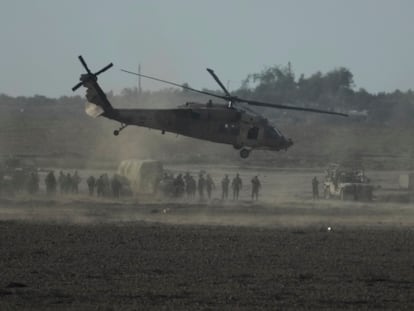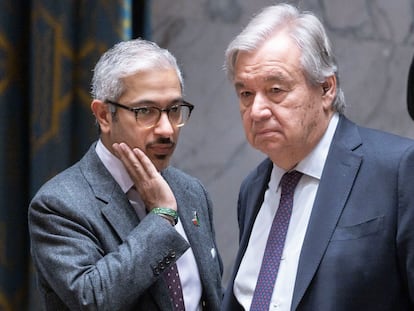Israel pushes Gaza to the brink of humanitarian collapse
Washington’s decision to veto a ceasefire, despite desperate appeals from organizations on the ground, has worsened the situation in the Palestinian enclave

The United States’s decision to veto U.N. Security Council efforts to end the fighting in Gaza is the latest blow to an extreme situation that is deteriorating by the minute. The humanitarian crisis is deepening, with NGOs only able to provide minimal help due to the Israeli blockade. It’s a hellish scenario: hundreds of Gazans queuing at a toilet, aid trucks and warehouses robbed, children amputated without anesthesia, tens of thousands of people abandoned. This is what it is being faced by the 1.8 million people who have been displaced to the south of Gaza, now a giant mousetrap of war. Local authorities, in the hands of the Hamas militia, put the death toll in Gaza at 17,500.
In the south of Gaza, the population of the enclave is increasingly imprisoned in fewer square miles, while the Israeli army intensifies its attacks and continues to close the door to the entry of aid. “Those who survive the bombings face the imminent risk of dying from hunger or disease,” warns Alexandra Saieh, from the NGO Save The Children. Despite this, the Israeli army continues its policy of forcibly displacing civilians and on Saturday ordered them to leave six areas of the city of Khan Younis, the southern stronghold of Hamas and the scene of intense fighting. Health authorities showed images that they claim were of the Nasser hospital, in which victims of all ages are seen receiving assistance among pools of blood on the floor.
With its veto, Washington has ended the hopes of a ceasefire and backed Israel’s sweeping offensive, which is attacking Hamas with a military steamroller without taking into account the hundreds of thousands of civilians who were not involved in the conflict. Of the current 15 members of the U.N. Security Council, 13 supported the resolution seeking a ceasefire. The United Kingdom abstained. Palestinian President Mahmoud Abbas blamed the U.S. veto “for the bloodshed of Palestinian children, women and the elderly.” Israeli Prime Minister Benjamin Netanyahu praised what the U.S. veto as the “correct position,” arguing “it is impossible, on the one hand, to support the elimination of Hamas and, on the other, to call for the end to the war.” That is why “Israel will continue its just war,” he continued.
Criticism of Washington’s veto has spread across the world. Important human rights organizations have lambasted the U.S.’s decision. Doctors Without Borders (MSF) said that President Joe Biden’s administration is providing “diplomatic cover for the ongoing atrocities being committed in Gaza.” “The U.S. has displayed a callous disregard for civilian suffering in the face of a staggering death toll, extensive destruction and an unprecedented humanitarian catastrophe,” Agnès Callamard, secretary general of Amnesty International, said in a statement. “By continuing to provide Israel with weapons and diplomatic cover as it commits atrocities, including collectively punishing the Palestinian civilian population in Gaza, the U.S. risks complicity in war crimes,” added Louis Charbonneau, Human Rights Watch’s (HRW) director at the U.N.
Little action is being taken by the international community. Meanwhile, people in Gaza continue to suffer, says Jesús Núñez Villaverde, the co-director of the Institute for Conflict Studies and Humanitarian Action (IECAH). He believes that Israel is staging a “rapid and brutal” operation, even though its army “certainly does not lack the technology and means to be able to discriminate [between civilians and combatants] if they wanted.”
NGOs with teams deployed in the Gaza Strip argued on Thursday that Israel was using hunger, access to healthcare and forced displacement as “weapons of war.” They demanded not only a ceasefire, but for an “independent” international organization like the United Nations to take control of the entry of aid to the Palestinian enclave, where only a meager percentage of what is needed is getting in due to the Israeli blockade.
In some areas, nine out of 10 people have spent an entire day and night without anything to eat, according to data from the World Food Program (WFP). The situation has not continued to deteriorate since, after the one-week truce ended on December 1, the military ground operation spread through the center and south of Gaza. Intense fighting also continues in the north, in areas such as the Jabalia refugee camp and the Shuja’iyya neighborhood, in Gaza City, from where the vast majority of the population has escaped.
But the reality is that civilians cannot flee much further south due to the border with Egypt. In Rafah, the southernmost town, more and more people are living in makeshift tents, made with plastic, tarps and blankets. As a result, hundreds of thousands of inhabitants are increasingly concentrating in the south of Gaza, in what Shaina Low, from the Norwegian Refugee Council (NRC), described as an “apocalyptic” situation. Before Israel’s offensive in Gaza, the Palestinian enclave was already one of the most densely populated places on the planet.
With little aid entering Gaza, the population is getting desperate. On Tuesday, a group attacked a Doctors Without Borders (MSF) truck in search of food, but the vehicle was only carrying medicine. The NRC also lost contact with their team “because the internet cable had been cut to be used for a tent,” explained Low.
The map that Israel presented last week to supposedly warn residents of where it was going to attack has turned out to be a fiasco, despite the order to evacuate those six areas of Khan Younis on Saturday. Humanitarian organizations say that it has not prevented deaths and has only multiplied the number of internally displaced people in a territory in which 60% of the buildings are destroyed or damaged.
“It is a cruel system,” said Defourni, from MSF, who regrets that her organization is not even allowed to take the wounded to Egypt. The supposed safe zones outlined by the Israeli army are a “smokescreen,” said Saieh, from Save The Children. For Bushra Khalidi, from the NGO Oxfam, the system is nothing more than a “mirage,” since the supposedly safe zones “do not offer protection, are not supplied and are inaccessible.”
They NGOS are referring to tracts of land such as Al Mawasi, a desert area in southwestern Gaza, where tens of thousands of people are being forcibly sent. “There are no services there. There are no schools. There are no health centers. There is nothing,” confirmed Danila Zizi, from Handicap International. These representatives spoke at an NGO meeting last Thursday, open to journalists, that included MSF, Oxfam, Amnesty International, Refugees International, Save The Children, Doctors of the World, Action Against Hunger (AAH) and Handicap International.
“People are breaking into houses looking for bathrooms. The population is very angry, depressed and desperate about what they are experiencing. It is afraid,” explained Chiara Saccardi (ACH), who warned that Gaza lacks basic products such as diapers, wipes and detergent. “Water is sold in the market at a high price. That can cost a family $20 a day,” she added. Due to the lack of hygiene products and the consumption of contaminated water, around 80,000 patients have contracted diarrhea, which is especially dangerous for young children as they are at greater risk of dehydration. Minors represent approximately half of Gaza’s 2.3 million inhabitants.
Some Israeli officials refer to Gazans as “human animals,” says security analyst Núñez Villaverde, who points out that this thinking convinces them that “there is no reason to give them food, drink, or anything like that.” According to Núñez Villaverde, “we are facing a theatrical farce in which the United States pretends to be putting pressure on, but in reality is providing diplomatic and military cover so that Israel can achieve its objectives at the pace and in the manner it deems appropriate.” But he argues that Israel “will never eliminate Hamas because it is militarily impossible.”
Retired Israeli general Giora Eiland defends his country’s use of blocking humanitarian aid to achieve its objectives. He believes that it is necessary to prevent the arrival of “any supplies to Gaza, especially fuel,” arguing that it would benefit Hamas. He does not understand why Israel continues to allow the entry of some trucks with humanitarian aid without obtaining the release of more hostages in exchange. On Friday, the death of a hostage was announced after a failed rescue attempt by troops deployed in the Gaza Strip. There are still 138 hostages in Gaza. Sixteen have died since the October 7 attack. That day, Hamas killed around 1,200 people, according to Israel, in the largest attack recorded in the country’s 75-year history.
Sign up for our weekly newsletter to get more English-language news coverage from EL PAÍS USA Edition
Tu suscripción se está usando en otro dispositivo
¿Quieres añadir otro usuario a tu suscripción?
Si continúas leyendo en este dispositivo, no se podrá leer en el otro.
FlechaTu suscripción se está usando en otro dispositivo y solo puedes acceder a EL PAÍS desde un dispositivo a la vez.
Si quieres compartir tu cuenta, cambia tu suscripción a la modalidad Premium, así podrás añadir otro usuario. Cada uno accederá con su propia cuenta de email, lo que os permitirá personalizar vuestra experiencia en EL PAÍS.
¿Tienes una suscripción de empresa? Accede aquí para contratar más cuentas.
En el caso de no saber quién está usando tu cuenta, te recomendamos cambiar tu contraseña aquí.
Si decides continuar compartiendo tu cuenta, este mensaje se mostrará en tu dispositivo y en el de la otra persona que está usando tu cuenta de forma indefinida, afectando a tu experiencia de lectura. Puedes consultar aquí los términos y condiciones de la suscripción digital.
More information
Archived In
Últimas noticias
Most viewed
- Sinaloa Cartel war is taking its toll on Los Chapitos
- Oona Chaplin: ‘I told James Cameron that I was living in a treehouse and starting a permaculture project with a friend’
- Reinhard Genzel, Nobel laureate in physics: ‘One-minute videos will never give you the truth’
- Why the price of coffee has skyrocketed: from Brazilian plantations to specialty coffee houses
- Silver prices are going crazy: This is what’s fueling the rally











































